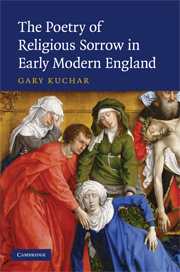Book contents
- Frontmatter
- Contents
- Acknowledgments
- Abbreviations and notes on texts
- Introduction: Of Sighs and Tears
- Chapter 1 The poetry of tears and the ghost of Robert Southwell in Shakespeare's Richard II and Milton's Paradise Lost
- Chapter 2 The poetry of tears and the metaphysics of grief: Richard Crashaw's “The Weeper”
- Chapter 3 The poetry of tears and the metaphysics of grief: Andrew Marvell's “Eyes and Tears”
- Chapter 4 Sad delight: Theology and Marian iconography in Aemilia Lanyer's Salve Deus Rex Judaeorum
- Chapter 5 Petrarchism and repentance in John Donne's Holy Sonnets
- Chapter 6 John Donne and the poetics of belatedness: Typology, trauma, and testimony in An Anatomy of the World
- Conclusion
- Index
- References
Chapter 1 - The poetry of tears and the ghost of Robert Southwell in Shakespeare's Richard II and Milton's Paradise Lost
Published online by Cambridge University Press: 22 September 2009
- Frontmatter
- Contents
- Acknowledgments
- Abbreviations and notes on texts
- Introduction: Of Sighs and Tears
- Chapter 1 The poetry of tears and the ghost of Robert Southwell in Shakespeare's Richard II and Milton's Paradise Lost
- Chapter 2 The poetry of tears and the metaphysics of grief: Richard Crashaw's “The Weeper”
- Chapter 3 The poetry of tears and the metaphysics of grief: Andrew Marvell's “Eyes and Tears”
- Chapter 4 Sad delight: Theology and Marian iconography in Aemilia Lanyer's Salve Deus Rex Judaeorum
- Chapter 5 Petrarchism and repentance in John Donne's Holy Sonnets
- Chapter 6 John Donne and the poetics of belatedness: Typology, trauma, and testimony in An Anatomy of the World
- Conclusion
- Index
- References
Summary
With the support of the underground Catholic network operating between England and the Continent, the twenty-four-year-old Robert Southwell made his way back to England under the cover of night sometime in July of 1586. Having completed his training in the Jesuit Order at the English College in Rome, Southwell returned to England with his Jesuit superior, Henry Garnet, as part of the clandestine Catholic mission. One of the things that Southwell brought with him from Italy as an important part of this mission was an accomplished ability to write in the “literature of tears” tradition – the Counter-Reformation practice of depicting the experience of repentance in varying prose and verse forms. Despite its Jesuit origins in England, this tradition would come to exercise a significant influence on English literary history, leading to the widespread popularity of “tear literature” in the 1590s and inspiring various “tear poems” throughout the seventeenth century. While Southwell's influence on the popularity of tear poetry in England has been well documented, our understanding of the philosophical and theological work performed by the tradition is still lacking, particularly the work performed by parodies of the poetry of tears. Seeking to demonstrate the cultural work performed by the poetry of tears and aiming to account for its power of fascination as a genre, the following three chapters trace some of the revisionings of the tradition popularized by Southwell in works by Shakespeare, Milton, Herbert, Crashaw, Marvell, and others.
- Type
- Chapter
- Information
- The Poetry of Religious Sorrow in Early Modern England , pp. 31 - 76Publisher: Cambridge University PressPrint publication year: 2008



